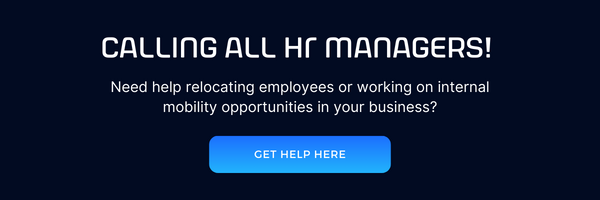What Is Internal Mobility? Why Is It Important?

As an HR manager, you hold a pivotal role in shaping your company’s success. One area where your influence can make a substantial difference is internal mobility.
Internal mobility, the practice of facilitating career growth and opportunities within your organization, not only fosters employee satisfaction but also strengthens your company’s overall performance.
In this article, you will delve into the mobility strategies and tactics that will empower you to enhance internal mobility within your organization.
Types of Internal Mobility
Let’s break down some of the specific types of internal mobility:
Role-to-Role Mobility
Role-to-role employee mobility, also known as lateral mobility, involves employees moving horizontally within the organization without a significant change in job level or hierarchy.
This type of internal mobility focuses on acquiring new skills, gaining diverse experiences, and broadening an employee’s skill set. Here’s a closer look at its characteristics:
Same Level: Employees move to a different role or position at the same hierarchical level. For example, a marketing manager becomes a product manager or a software engineer transitions to a quality assurance role.
Skill Expansion: The primary goal is to develop a broader skill set or explore different aspects of the organization without the added responsibilities of a promotion.
Employee Choice: Often, employees choose role-to-role mobility to explore new challenges, work on different projects, or pursue areas of interest within the organization.
Upward Mobility
Internal upward mobility refers to the movement of employees within an organization as they progress to positions of higher responsibility, authority, and often, higher pay.
This type of employee mobility program involves promotions and career advancement. Here’s what you need to know regarding its characteristics:
Hierarchy Climb: Employees move up the organizational hierarchy, typically by taking on roles with increased responsibilities, such as moving from a team leader to a department manager.
Performance-Driven: Upward mobility is often performance-based, with employees needing to demonstrate their competence and potential to assume more significant roles.
Salary Increase: Along with increased responsibilities, upward mobility often comes with higher compensation.
Project-Based Mobility
Project-based mobility involves temporarily assigning employees to specific projects, task forces, or cross-functional teams to address unique challenges or opportunities. This type of mobility can enhance skills and foster innovation. Here are some characteristics:
Temporary Assignments: Employees are temporarily taken from their current roles to work on projects outside their regular job descriptions.
Cross-Functional Collaboration: Teams often consist of individuals from different departments or functions who bring diverse expertise to the project.
Skill Development: Project-based mobility provides an opportunity for employees to develop new skills and gain valuable experiences.
Transfers
Transfers refer to the movement of employees from one location, department, or branch of the organization to another. This can happen in a corporation’s downsizing. Transfers can be lateral (same level) or involve promotions (upward mobility) depending on the specific circumstances. Here are some characteristics:
Location or Department Change: Employees may move to a different geographical location or switch to a different department or business unit.
Purpose Varies: Transfers can be driven by various reasons, including organizational needs, employee preferences, or skills alignment.
Hierarchy Implication: Transfers can involve lateral moves to address workforce needs or upward moves for career development or talent retention.
The Significance of Internal Mobility
Internal career mobility is more than just a buzzword; it’s a critical aspect of HR management. Here’s why it matters:
Retaining Top Talent: In today’s competitive job market, retaining top talent is a constant challenge. Internal mobility can help by providing a clear path for career progression within your organization, reducing the temptation for employees to seek opportunities elsewhere.
Boosting Employee Morale: When employees see that their company invests in their growth, they are more engaged and motivated. This improved morale translates into higher productivity and job satisfaction.
Reducing Recruitment Costs: External hires often require extensive training and onboarding. Promoting from within can save your company time and resources when it comes to recruitment costs.
Fostering Diversity and Inclusion: A robust internal mobility program can help your organization promote diversity and inclusion by providing equal opportunities for all employees to advance their careers.
Strategies to Enhance Internal Mobility
Now that we’ve identified the importance of internal mobility and how to overcome common challenges, let’s explore concrete strategies to enhance it within your organization:
Develop a Comprehensive Talent Review Process: Regularly assess your employees’ skills, performance, and potential for growth. Identify high-potential individuals and create tailored development plans to nurture their talents.
Establish Clear Career Pathways: Create well-defined career paths within your organization, complete with skill and experience requirements for each level. This transparency provides employees with a roadmap for advancement.
Invest in Training and Development: Provide ongoing training opportunities, mentoring programs, and access to resources that enable employees to acquire new skills and competencies.
Implement a Robust Internal Job Posting System: Ensure all job openings are posted internally before considering external candidates. This practice not only encourages employees to apply but also allows you to tap into the existing talent pool.
Encourage Cross-Functional Movements: Promote cross-functional mobility by encouraging employees to explore different roles and departments within the company. This broadens their skill set and fosters a deeper understanding of the organization.
Create an Employee-Centric Culture: Cultivate a culture that values and prioritizes employee growth and development. Recognize and reward employees who actively seek out new opportunities within the company.
Internal Mobility: FAQs?
How can the ARC Realtor Rebate Program Help?
The ARC Realtor Rebate Program can help your employees if they need to transfer to a different location.
As a homebuyer or seller, your employees may be eligible to receive a cash rebate on the purchase or sale price of their property. This can help your employees save thousands of dollars on the purchase of their next home and it can help with relocation expenses.
What are the main benefits of internal mobility?
Internal mobility offers several significant benefits for both employees and organizations. For employees, internal mobility offers career growth and advancement, skill development, stability, job satisfaction, and a reduced commute.
For organizations, internal mobility offers talent retention, cost savings, improved productivity, diversity and inclusion, knowledge transfer, and enhanced employee engagement.
Are there specific strategies for promoting internal mobility in remote work environments?
Yes, many companies offer workforce mobility. In remote work environments, organizations can focus on virtual or remote mobility by offering opportunities for employees to work from different locations, collaborate remotely on projects, and participate in online training and development programs.
Effective communication and technology solutions are essential in facilitating remote internal mobility.
Conclusion
As an HR manager, you possess the tools to transform your organization’s internal mobility landscape.
By recognizing the importance of internal mobility, overcoming common challenges, and implementing effective strategies, you can unlock the potential of your workforce and drive your company to new heights.
Contact ARC Relocation today for help navigating internal mobility throughout your company.

